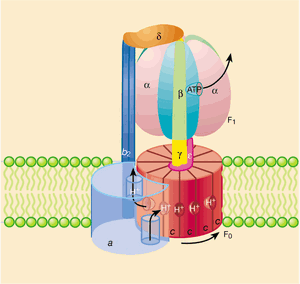Chemical Reaction
The advantage of using oxygen as the final electron acceptor is the amount of energy that is subsequently made available. Also, the large increase in reduction potential between NADH (or FADH2) and oxygen and the corresponding change in free energy (ΔG) is not wasted. It is used to pump protons (H+) from the matrix of the mitochondria to the intermembrane space.
The flow of electrons through the Complexes I, III and IV is associated with the pumping of a certain amount of protons to one pair of electrons. Complex II does not transfer any protons. Since the inner mitochondrial membrane is highly impermeable to protons, a proton gradient occurs on it (the amount of protons is greater in the intermembrane space than in the matrix). A higher concentration of protons means a lower pH and a positive electrical potential. The intermembrane space therefore has a more acidic environment and is positively charged with respect to the matrix. The membrane potential of a mitochondrion is usually expressed as a voltage.
In the mitochondrion, the energy of the proton gradient on the inner membrane is used to produce another kind of energy – chemical energy stored in ATP molecules.
ATP synthesis is catalyzed by the enzyme F1·F0-ATP synthase. The F0 subunit forms a channel across the mitochondrial inner membrane, allowing the return of protons from the intermembrane space back into the matrix. The flow of protons down the electrochemical gradient is used to rotate part of the enzyme. The rotation is then transmitted to the central axis (stalk) of the F1 subunit of the enzyme, which presses on the outer subunits. These are held immobile by a connection with the peripheral stalk (axis), and thus the phosphorylation of ADP to ATP is driven on them. The F1 subunit has three ATP synthesis sites, so one complete turn will allow the formation of three ATP molecules.
A specific transporter (ANT – adenine nucleotide translocator) subsequently transfers the newly synthesized ATP molecules in exchange for ADP out of the matrix and into the cytoplasm.

